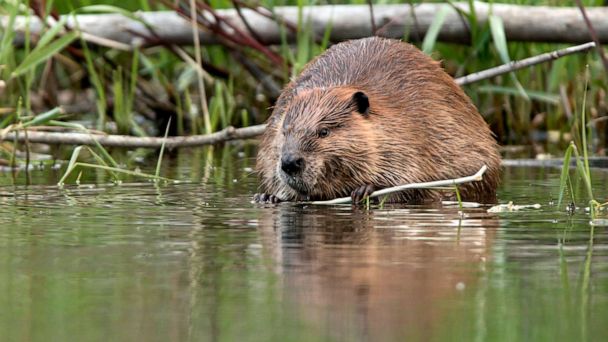Photo: In this undated file photo, a beaver appears near the shoreline of the Bear Creek which feeds into the South Platte River just outside Denver, Colorado. STOCK IMAGE/Getty Images
Humans can take a lesson from beavers’ engineering on how to conserve water.
The humble beaver could become one of America’s hardest working allies in the race to adapt to climate change.
Beavers are natural engineers. They instinctively build dams and canals of water to keep themselves safe because they’re clumsy on land. And capturing that water creates ecosystems for other animals to survive, earning beavers the moniker of a “keystone species.”
A growing movement of nonprofits, experts and government agencies see a potential to take a lesson from beavers’ natural engineering prowess to capture more of that water for the places that desperately need it.
“Beavers benefit a lot of things in the context of climate change,” Emily Fairfax, assistant professor of environmental science and resource management at California State University Channel Islands, told ABC News.
“The ones that are most directly sort of in our eyesight right now is the beavers’ ability to protect ecosystems during droughts, during floods, during wildfires, during extreme disturbances. And in those patches of habitat that they’re protecting, there’s a huge amount of biodiversity.”
In addition to storing water, Fairfax’s research has shown that areas with beaver dams are more resilient to wildfires because the plants and trees are so wet they don’t burn. And she said they could help capture water from extreme rain events like the atmospheric rivers in California to be accessed by those water systems later.
“Beavers sort of figured this out instinctually over 7 million years of evolution that their dams and their canals work because they take the whole hydrologic cycle and they just make it more stable, more consistent,” she said.
Beavers haven’t always been recognized for their benefits. Fur trapping dramatically reduced the population starting in the 1700s and even today beavers are sometimes seen as a nuisance and killed. The animals are sometimes relocated away from urban areas where their dams could cause disruptions and flooding, which experts like Fairfax said can sometimes be appropriate but is not always the right approach.
Instead of treating them like pests, groups like the National Forest Foundation are looking to take a lesson from beavers’ work to find a nature-based approach to adapt to impacts of climate change like worsening drought conditions.
“There’s a lot of streams and headwaters to the Colorado River that used to run perennially, year-round, that we now see have stopped. And so we might be able to, as we do enough of these, turn some of those stream flows back on […]
Full article: How beavers could help the Colorado River survive future droughts
Also see: The Science Behind Atmospheric Rivers


